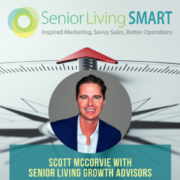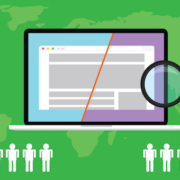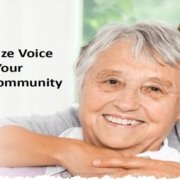Editor’s note: The following senior living sales content was inspired by discussions during our COVID-19 Webinar, which you can access for free here.
COVID-19 has forced all of us to change many aspects of our personal and professional lives, and this is especially true for senior living sales pros.
But here’s the good news: The adjustments you make to your sales process right now can serve you well over the long haul. Below are just some of the adjustments to consider:
1. Senior living sales tips: Stop selling. Start helping.
You’ve likely heard this advice before, especially if you’re a regular reader of our blog and newsletter. This isn’t a new strategy, by any stretch. But now is a great time to try it, especially if you’ve been skeptical of the concept.
So what do we mean by “stop selling, start helping“? No one likes being sold to (and definitely not during a global pandemic). But people do tend to be grateful for genuine help and concern.
Whenever you speak to a “prospect,” particularly during these uncertain times, forget the word “prospect.” Don’t think “how can I move this person to the next stage in the journey?” Instead, think of the word “human” and think about how you can help this fellow human.
Begin by asking questions…
- How are you and your family adjusting to social-distancing measures?
- What sort of activities are you doing?
- What do you miss most?
- Have you watched or read anything good lately?
- What do you need help with?
- What supplies are your running low on?
- How can I help/be of service to you right now?
Listen to their answers. Share your experiences as well. And if they need help with something, help them—get them answers to their questions, follow up in a meaningful way, drop off a care package at their door.
And guess what? If you build stronger relationships by making a real connection and demonstrating genuine empathy, you will naturally move people closer to a purchase decision when the time comes. And when the pandemic is over, you’ll find that most of the prospects will see you in a very different (and more positive) light. You’ll have created a much stronger and enduring bond than you ever could have done when you were in constant selling mode.
A final note on this strategy: Yes, these sorts of conversations with prospects will take longer. But you’ve got the time, right? And here’s an important tip: try having these conversations face-to-face via virtual methods.
Which brings us to our next point . . .
2. Senior living sales tips: Make an effort to move from voice-to-voice contact to (virtual) face-to-face.
In the “old” days of just a few months ago, making follow-up phone calls to prospects was the norm. And it worked fine. A phone call was more personal than an email—hearing someone’s voice and all that. But given social distancing and the isolation we’ve all found ourselves in, we’re all craving VISUAL contact right now.
You already know that seeing someone’s face (and being able to read nonverbal gestures) can be critical to the sales process. You now have the opportunity to make visual contact a regular part of your sales follow-up process.
Use apps like Zoom or Facetime to connect with prospects. This visual contact better enables you to develop a relationship with a person, rather than a prospect. It also allows the person to see YOU as a human being rather than merely a sales rep trying to sell them something.
Suggesting video calls right now isn’t a hard sell, either. People around the globe are using these modes of communication to keep in touch with family and friends, so they are poised to accept this sort of communication from businesses as well.
In fact, Axios reports that this year’s Easter and Passover celebrations forced many older Americans to take the plunge and try video conferencing, like Zoom, for the first time. And Axios also wisely notes, “Older generations are usually slow to adopt new technologies, but history shows that when they finally do learn, they’re hooked.”
3. Senior living sales tips: Include more virtual events in your overall event planning.
Why have more virtual events, especially once things have improved? Well, COVID-19 has taught all of us that how we interact with brands and companies—including how we buy from them—can and will continue to evolve.
Not every sale—even for big-ticket items, like new living quarters—has to be done in person, thanks to technology. This is true, even for senior living communities. Some of our clients are reporting to us that they’re still making sales and move-ins during this time, albeit creatively and with much less in-person contact.
And now that consumers are seeing that they don’t need as much in-person time with sales people in order to successfully purchase something, demand for virtual sales processes will likely increase.
As a result, senior living sales and marketing teams will need to get creative and offer more virtual ways to engage prospects. This will be especially true for so-called “bottom of the funnel” events, like in-person tours, open houses, and lunches.
An important caveat: We don’t think virtual events are going to replace in-person events. But including virtual events in your offerings gives people (aka, your prospects) more choices—and ultimately more control.
4. Senior living sales tips: Clean up/update your CRM—and keep it updated.
No more excuses. You have the time to clean up your CRM, so do it.
Of course, the real problem isn’t the cleanup, though; it’s maintaining a clean database by getting in the habit of logging all details after every call on a go-forward basis
Again, you have the time right now. So after every call—even the long ones—get in the habit of immediately updating the contact record in your database with notes, info on the follow-up call, and any relevant tasks. For example, if you were talking to someone who was unsure about senior hours at the area grocery stores, assign yourself a task to get a list to the person ASAP. This goes back to the “stop selling, start helping” point above.
Note: Don’t have a CRM? (Or maybe you’re thinking of making a switch?) Here are six crucial elements to consider when choosing the right CRM.
5. Senior living sales tips: Focus less on lead volume and more on conversions.
Listen, we get it. You’re in sales. You live and die by the numbers. But consider this: would you rather have a ton of leads that never convert or a smaller amount of leads with a high conversion rate?
Lead volumes are down across the board due to the pandemic—some of our clients are reporting by more than half. But our most successful clients are working the leads they have in a sensitive and empathetic manner (see point #1 above) and seeing an increase in conversions as a result.
Think about that, because it’s a powerful point. Nurture leads in a more authentic, real way, and possibly convert more of the leads you already have. That’s not a bad approach right now—or in the future when we’re (hopefully) back to normal.
Need help thinking through your sales process post COVID—and aligning it better with marketing?
We can help. We’ve been in your shoes. We understand the enormous pressures you’re facing! Let’s chat.
MORE HELPFUL TOPICS:
What Can Sales People Do If They Cannot Sell?
Tips for Creating Virtual Sales Experiences in Senior Living
Senior Living Sales Tips: Characteristics of Super Star Sales Talent













